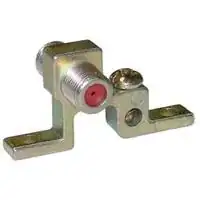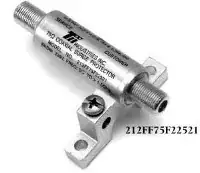Can anyone point me to any coax-extending fiber hardware?
No, coax is broadband (in the radiological sense, not the marking hype sense). Fiber is baseband. You can not convert from one to the other without something processing every discrete signal separately. This takes immensely expensive and complicated equipment.
Would this introduce substantial latency?
Converting from one medium to another typically introduces a few microseconds of latency. Not worth mentioning in most contexts. But this is largely irrelevant in your case.
Your client will want two things:
One well grounded Coax Ground Block. Typically installed at the point of premise entry. The ground wire should be at least 12ga solid core. Consult an electrician if this is not readily available.
A Coax Ground Block looks like this and are usually installed by the cable company:

This device has a high impediance path to ground, which allows the circuit to dissipate static charge and provides a minor path of least resistance to ground. It does not interrupt the path through to your devices under any circumstances however; so any significant lightning strike will go straight through it.
One F-Type Lightning Protector. Get a few replacement tubes as they can be hard find the right size for older protectors. This too needs to be well grounded, at least as well as the ground block, and must be connected to the same ground source.
A F-Type Lightning Protector is not commonly installed by the cable company:

This device has no link between the signal path and ground. It has a "tube" in the middle with a fusible link (ie, it melts easily upon heavy load and the ends "pull back" from the center making the "jump" through the center harder the hotter it gets - high end models are filled with arc suppression gas, but most are just filled with plain CO2). When the fusible link melts it routes the "incoming" circuit to ground, disconnecting the "outgoing" signal path completely. The one pictured is a cheap ($20-25 USD as of writing) model without a replicable tube.
Typically each piece of grounded equipment has it's own green 12ga+ wire running back to nearby electrical box with a ground bus. If a box is not available nearby then the individual grounds are aggregated to eliminate the potential for ground loops. Any building built in the last few decades will have a good ground system - if in doubt get an electrician to look it over.

